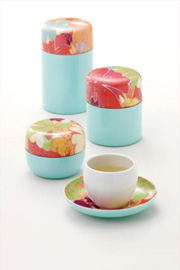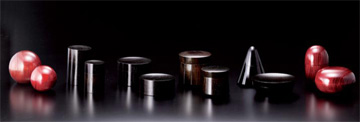Home > Highlighting JAPAN > Highlighting Japan NOVEMBER 2011 > The JOY of Yamanaka Lacquer
Highlighting JAPAN
JAPAN BRAND
The JOY of Yamanaka Lacquer
The lacquerware-making group of companies Nussha has brought the traditional craftsmanship of Yamanaka in Ishikawa Prefecture to sophisticated markets around the world. Gavin Blair reports.

The Venie range of tableware tea holders and other containers incorporates fabric in the manufacturing process, ensuring that each item is unique.
Credit: COURTESY OF NUSSHA
As the reputation of the turned woodenware spread, Yamanaka became a supplier of it to other lacquerware production areas around the country. Meanwhile, more sophisticated lacquering techniques were introduced from those areas to Yamanaka. The lacquerware industry continued to develop, and by the early postwar period had become the biggest in Japan by incorporating modern production techniques into its traditional craftsmanship.
Yamanaka lacquerware was officially designated a traditional craft by the government in the 1970s, and formal training and qualifications for the industry have since been introduced. The local craft guild, the Yamanaka Lacquerware Union, created a certification system to ensure products from the area have been through the four individual processes by four different artisans. The four stages used to create authentic Yamanaka lacquerware are wood-turning, priming, coating and lacquer painting; these products are given the JOY (Japan Original Yamanaka) stamp of approval.
Tatsumiya is one of the numerous lacquerware companies that continue the local industry despite the challenges of cheap imports. Formed in 1945, the company flourished through the decades of high economic growth as its products proved particularly popular as gifts in the booming wedding industry. After the bursting of the economic bubble in the early 1990s, the company shifted its emphasis to everyday tableware, including plastic bento lunch-boxes, while still maintaining some of its traditional lacquerware ranges.

Skillfully turned from well-seasoned Japanese zelkova wood, the rims of the containers in the Innocent range are less than 3 mm thick, making them lightweight and thus portable.
Credit: COURTESY OF NUSSHA
"We formed Nussha with seven local companies to join the Japan Brand project to focus on overseas sales," says Yamaguchi. "We had the monodzukuri skills for lacquerware here in Yamanaka, but to understand the needs of foreign markets, and also to communicate overseas, we linked up with Tomita Kazuhiko, a Milan-based Japanese designer. We could then use a 'made in Yamanaka, designed in Milan, sold in Paris' tag for the ranges we displayed at the Maison D'Objet exhibition in France which we first participated in during 2005," says Yamaguchi.
The Nussha ranges were then sold in museum shops and other selected outlets in Paris and London.
Bodies involved in the life science and nanotechnology research fields are now starting to use K computer. From next year, K computer will be used in what the government designates as strategic fields for next-generation supercomputer use: life science/medical, new materials and energy creation, global change prediction, industrial innovation, and origin of matter and the universe.
"We got a lot of interest from the European media so we had great sales even in those early years of about 40 million yen annually," explains Yamaguchi.
"After we attracted a lot of attention in Europe, then Japanese buyers attending the Maison D'Objet also became interested and we started selling in the domestic market the following year via a kind of reverse import route," says Yamaguchi.
The Nussha group currently has five companies participating and it is now using local designers from Ishikawa Prefecture, as well as collaborating with students from the nearby Kanazawa College of Art.
The Venie range of plates, saucers, bowls, tea holders, boxes and trays, the first range Tatsumiya created for Nussha, remains its best-seller. The distinctive look is created by using kimono-like fabric in the manufacturing process, ensuring that no two pieces are exactly the same.
"What we've learned from working as part of Nussha, in terms of design and marketing, we've also been able to put to use in the other parts of our business," says Yamaguchi.
© 2009 Cabinet Office, Government of Japan






